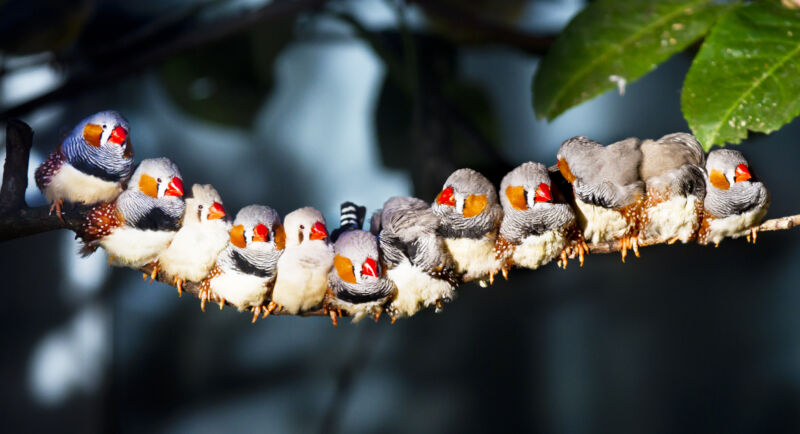
In our quest to find what makes humans unique, we often compare ourselves with our closest relatives: the great apes. But when it comes to understanding the quintessential human capacity for language, scientists are finding that the most tantalizing clues lie farther afield.
Human language is made possible by an impressive aptitude for vocal learning. Infants hear sounds and words, form memories of them, and later try to produce those sounds, improving as they grow up. Most animals cannot learn to imitate sounds at all. Though nonhuman primates can learn how to use innate vocalizations in new ways, they don’t show a similar ability to learn new calls. Interestingly, a small number of more distant mammal species, including dolphins and bats, do have this capacity. But among the scattering of nonhuman vocal learners across the branches of the bush of life, the most impressive are birds—hands (wings?) down.
Parrots, songbirds, and hummingbirds all learn new vocalizations. The calls and songs of some species in these groups appear to have even more in common with human language, such as conveying information intentionally and using simple forms of some of the elements of human language such as phonology, semantics, and syntax. And the similarities run deeper, including analogous brain structures that are not shared by species without vocal learning.
These parallels have motivated an explosion of research in recent decades, says ethologist Julia Hyland Bruno of Columbia University, who studies social aspects of song learning in zebra finches. “Lots of people have made analogies between language and birdsong,” she says.
Hyland Bruno studies zebra finches because they are more social than most migratory birds—they like to travel in small bands that occasionally gather into larger groups. “I’m interested in how it is that they learn their culturally transmitted vocalizations in these groups,” says Hyland Bruno, coauthor of a paper in the 2021 Annual Review of Linguistics comparing birdsong learning and culture with human language.
Both birdsong and language are passed culturally to later generations through vocal learning. Geographically distant populations of the same bird species can make small tweaks to their songs over time, eventually resulting in a new dialect—a process similar in some ways to how humans develop different accents, dialects, and languages.
With all these similarities in mind, it’s reasonable to ask if birds themselves have language. It may come down to how you define it.
“I wouldn’t say they have language in the way linguistic experts define it,” says neuroscientist Erich Jarvis of the Rockefeller University in New York City and a coauthor of Hyland Bruno’s paper on birdsong and language. But for scientists like Jarvis who study the neurobiology of vocal communication in birds, “I would say they have a remnant or a rudimentary form of what we might call spoken language.
“It’s like the word ‘love.’ You ask lots of people what does it mean, and you’re going to get a lot of different meanings. Which means that it’s partly a mystery.”
There are multiple components to spoken language, Jarvis says, and some are shared by more species than others. A fairly common component is auditory learning, like a dog figuring out how to respond to the spoken command “sit.” The vocal learning that humans and some birds do is one of the most specialized components, but all of them are shared to some degree by other animals, he says.
The grammar of bird calls
One key element of human language is semantics, the connection of words with meanings. Scientists had long thought that unlike our words, animal vocalizations were involuntary, reflecting the emotional state of the animal without conveying any other information. But over the last four decades, numerous studies have shown that various animals have distinct calls with specific meanings.
Many bird species use different alarm calls for different predators. Japanese tits, which nest in tree cavities, have one call that causes their chicks to crouch down to avoid being pulled out of the nest by crows, and another call for tree snakes that sends the chicks jumping out of the nest entirely. Siberian jays vary their calls depending on whether a predatory hawk is seen perching, looking for prey, or actively attacking—and each call elicits a different response from other nearby jays. And black-capped chickadees change the number of “dees” in their characteristic call to indicate the relative size and threat of predators.
reader comments
85